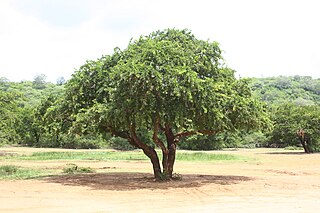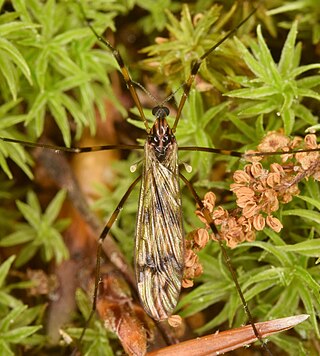
The humpback whale is a species of baleen whale. It is a rorqual and is the only species in the genus Megaptera. Adults range in length from 14–17 m (46–56 ft) and weigh up to 40 metric tons. The humpback has a distinctive body shape, with long pectoral fins and tubercles on its head. It is known for breaching and other distinctive surface behaviors, making it popular with whale watchers. Males produce a complex song typically lasting 4 to 33 minutes.

Schinus is a genus of flowering trees and tall shrubs in the sumac family, Anacardiaceae. Members of the genus are commonly known as pepper trees. The Peruvian pepper tree is the source of the spice known as pink peppercorn.

Limoniidae is the largest of four crane fly families, with more than 10,700 species in more than 150 genera. It is a paraphyletic assemblage of genera within the superfamily Tipuloidea. Although paraphyletic, Limoniid crane flies can usually be distinguished by the way the wings are held at rest. Limoniids usually hold/fold the wings along the back of the body, whereas other crane flies usually hold them out at right angles. Snow flies such as Chionea scita have no wings at all. Limoniids are also usually smaller than other crane flies, with some exceptions.

Limonia acidissima is the only species within the monotypic genus Limonia. Common names for the species in English include wood-apple and elephant-apple. It is sometimes also called monkey fruit.

Limonia is a genus of crane flies in the family Limoniidae. There are at least 430 described species in Limonia. It is somewhat of a 'catch-all' genus, where some members should rightly be placed elsewhere.
Limonia domestica is a species of limoniid crane fly in the family Limoniidae.
Sphaerophoria novaeangliae is a species of syrphid fly in the family Syrphidae.

Limoniini is a tribe of limoniid crane flies in the family Limoniidae. There are about 7 genera and more than 1,400 described species in Limoniini.
Limonia immatura is a species of limoniid crane fly in the family Limoniidae.
Limonia cinctipes is a species of limoniid crane fly in the family Limoniidae.

Limonia indigena is a species of limoniid crane fly in the family Limoniidae.
Limonia liberta is a species of limoniid crane fly in the family Limoniidae.

Limonia annulata is a species of limoniid crane fly in the family Limoniidae.
Limonia marmorata is a species of limoniid crane fly in the family Limoniidae.

Limonia communis is a species of limoniid crane fly in the family Limoniidae.
Limonia parietina is a species of limoniid crane fly in the family Limoniidae.
Limonia hudsonica is a species of limoniid crane fly in the family Limoniidae.
Limonia humidicola is a species of limoniid crane fly in the family Limoniidae. It can be found in Southern Canada, across the United States, and into Central America, commonly in shady, wet areas along streams.
Limonia shannoni is a species of limoniid crane fly in the family Limoniidae.
Limonia rostrata is a species of limoniid crane fly in the family Limoniidae.








